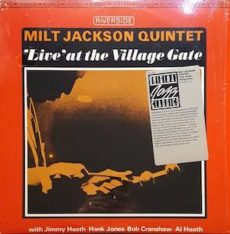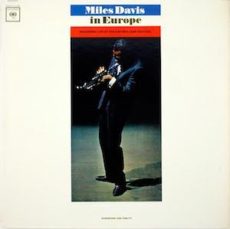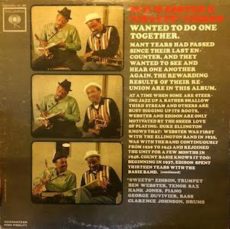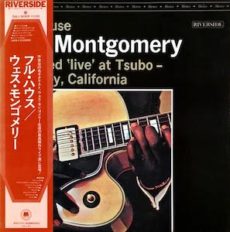
Requisites
Live At The Village Gate ~ Milt Jackson Quintet | By Eddie Carter
I’ve been a huge fan of Milt Jackson ever since seeing him in concert with The 1972 Newport Jazz All-Stars at Music Hall in New York City. He swung effortlessly that evening with solos that were exciting and spirited, and I began collecting all his albums. A few nights ago, I was listening to this morning’s choice from the library and that’s what prompted this discussion. Live at The Village Gate (Riverside RM 495/RS-9495) is a 1967 release documenting the vibraphonist leading a wonderful quintet, Jimmy Heath on tenor sax, Hank Jones on piano, Bob Cranshaw on bass, and Albert “Tootie” Heath (Jimmy’s brother) on drums. My copy used in this report is the 1987 Original Jazz Classics Stereo reissue (Riverside OJC-309 – RLP-9495).
Side One starts with the first of three tunes by Bags, a nickname given to Milt by a Detroit bass player that he would be called the rest of his life. Bags of Blue is a tune that’ll have you tapping your toes from the quintet’s lively melody. Milt opens with a peppy first solo, then Jimmy takes a sprightly reading. Hank makes everyone feel good on the next statement. Milt and Jimmy split the finale with a few verses ahead of the ensemble’s ending and club’s applause. Little Girl Blue by Richard Rodgers and Lorenz Hart is one of their prettiest compositions from the Broadway musical, Jumbo (1935). Bags and Hank make a dainty introduction, then Bob and Albert come in for the tender theme. As the song’s only soloist, Milt gives a gorgeous performance complemented by the trio’s delicately sensitive support.
Up next is an upbeat original by Jimmy Heath, Gemini. It made its first appearance on his album, Triple Threat (1962). The group begins the melody briskly, then Milt leads off the opening statement with high-spirited energy. Jimmy applies some vigorous passion to the second presentation. Hank closes with a dazzling reading before the quintet takes their exit. Jackson’s light-hearted Gerri’s Blues begins Side Two with the first of two sparkling solos by Hank preceding the ensemble’s theme. Bags takes the first solo and constructs an infectious interpretation that’s perfectly suitable for dancing. Hank keeps the happy beat alive on the next reading, followed by Jimmy’s extremely nimble solo. The leader and saxophonist engage in a three-way conversation with Albert leading to a very satisfying conclusion.
Time After Time by Sammy Cahn and Jule Styne is a beautiful jazz standard and the second quartet presentation featuring Bags as the lone soloist. The quartet states a delicately pretty melody, then Milt seamlessly moves into a statement of great tenderness and intimacy capable of melting even the coldest heart. The quintet ends the set with Jackson’s Ignunt Oil that Bags first recorded on Plenty, Plenty, Soul (1957). The group struts their stuff on the opening chorus in unison. Milt starts off the solos with a joyous workout. Jimmy follows with some inspired ideas. Hank comes in next and cooks at a nice momentum. Bags leads toward the close with a few final thoughts preceding the quintet’s perfect ending to a great set.
Live at The Village Gate was originally recorded by Ray Fowler. The remastering by Phil DeLancie delivers a spacious soundstage transporting the listener to the club with all the intimacy and ambiance of being there in person. The result is a great recording of swinging jazz by one of the consummate musicians, Milt Jackson. It’s also a good place to discover his immense discography as a leader, sideman, and principal member of The Modern Jazz Quartet in an illustrious career lasting forty years. If you’re a fan of Bags, Jimmy Heath, or Hank Jones, I invite you to check out Live at The Village Gate by The Milt Jackson Quintet on your next vinyl hunt. It’s a nice way to unwind after a long day with your favorite drink and in my opinion, would make a great addition to any jazzophile’s library!
~ Plenty, Plenty, Soul (Atlantic 1269/SD 1269), Triple Threat (Riverside RLP 400/RLP 9400) – Source: Discogs.com ~ Little Girl Blue, Time After Time – Source: JazzStandards.com © 2022 by Edward Thomas Carter
More Posts: choice,classic,collectible,collector,history,instrumental,jazz,music,vibraphone

Requisites
Miles Davis In Europe ~ Miles Davis | By Eddie Carter
This morning’s choice from the library is a 1964 live album by Miles Davis that’s an overlooked gem, in my opinion, Miles Davis In Europe (Columbia CL 2183/CS 8983). It documents the trumpeter in concert at the 1963 Antibes International Jazz Festival during a successful European tour that was also broadcast over RTF (Radiodiffusion-Télévision Française). He’s joined on stage by George Coleman on tenor sax, Herbie Hancock on piano, Ron Carter on bass, and Tony Williams on drums who also appeared on Seven Steps To Heaven recorded a few months earlier. My copy used in this report is the original US Mono album and Side One opens with the introduction of the quintet by Master of Ceremonies, André Francis.
Autumn Leaves by Joseph Kosma, Johnny Mercer, and Jacques Prévert opens with Miles’ muted introduction and excellent support by the rhythm section. They begin with a deceptively easy melody; he then picks up the pace on the opening chorus with a carefree swing. George steps up next with a buoyant statement that cooks, then Herbie takes flight for a scintillating interpretation. Ron walks with assurance briefly on the closer ahead of the group’s ending theme. The leader’s Milestones is off to the races on the quintet’s speedy melody. Davis soars into the stratosphere on the lead solo. Coleman shows he’s equally adept for speed on the second statement, and Hancock closes with a highly energetic performance leading to the group’s vigorous ending.
The quintet turns up the temperature a little more on Joshua by Victor Feldman with a torrid opening chorus. Miles takes off like a speedy gazelle on the first statement. George comes in next, dispensing a fierce intensity on the second reading, then Herbie goes on a high-spirited flight in the closer preceding the ensemble’s lively summation. Side Two gets underway with Miles returning to the mute for Cole Porter’s All of You. It first appeared in the Broadway musical, Silk Stockings (1955). He and the trio begin the song with an attractive melody. Davis starts the solos with a charmingly articulate interpretation. Coleman offers some cheerful notes in the second performance. Hancock takes the final solo swinging easily into the trumpeter’s closing chorus and soft climax.
Walkin’ by Richard Carpenter opens with a quick melody and a furious opening statement by Miles. Tony takes the stage next and sparkles on an energetic interpretation. George swings with a fiery flavor in the third reading and Herbie closes the solos with a thoroughly entertaining performance leading to the theme’s reprise and finish. Miles Davis In Europe was produced by Teo Macero and RTF was behind the dials for the broadcast recording. The sound quality is superb, placing the listener in the festival audience to enjoy the quintet’s set. Everyone is in top form throughout, this album captures the quintet’s fire during their performance, and the music cooks from start to finish. If you’re in the mood for some swinging live jazz, I offer for your consideration, Miles Davis In Europe. It’s worthy of wider recognition and makes a perfect complement to the group’s other live albums, My Funny Valentine and ‘Four’ & More!
~ ‘Four’ & More (Columbia CL 2453/CS 9253), My Funny Valentine (Columbia CL 2306/CS 9106), Seven Steps To Heaven (Columbia CL 2051/CS 8851) – Source: Discogs.com ~ Autumn Leaves – Source: JazzStandards.com ~ All of You – Source: Wikipedia.org © 2022 by Edward Thomas Carter
More Posts: choice,classic,collectible,collector,history,instrumental,jazz,music,trumpet

Requisites
Wanted To Do One Together ~ Ben Webster and Sweets Edison | By Eddie Carter
Benjamin Francis Webster and Harry “Sweets” Edison were two of jazz’s most beloved and respected musicians. Ben was affectionately known as “The Brute” for his sometimes coarse, harsh, or rough sound by his Ellington bandmates. However, he could also express deep feelings on any ballad or standard with a quiet intensity that always amazed fans listening to one of his albums or during his live performances. Webster was also an essential part of Duke Ellington’s orchestra before having a successful solo career. Johnny Hodges was a huge influence on Ben, and he credits the altoist with teaching him how to play the saxophone.
Harry was one of the most sought-after musicians in jazz and became a proficient trumpet accompanist and soloist for nearly twenty-five years. “Sweets” performed with Count Basie, toured with the Jazz at The Philharmonic All-Stars, and led his own orchestra. He also played in bands led by Gil Fuller, Dizzy Gillespie, Quincy Jones, Buddy Rich, and Shorty Rogers. Lester Young gave him the nickname “Sweets”, and his artistic proficiency and willingness to develop as jazz itself progressed made him one of the best trumpet players ever. Edison also possessed a bright, buoyant sound that could also be soft-spoken and serene.
In 1962, the two friends wanted to record an album together. The joyous result of their collaboration is Wanted To Do One Together (Columbia CL 1891/CS 8691), this morning’s choice from the library. The front line is fortified by Hank Jones on piano, George Duvivier on bass, and Clarence Johnson on drums. My copy used in this report is the original Mono album. Ben Webster’s Better Go opens Side One with a bouncy, upbeat melody by both horns. “Sweets” is off and running with an exhilarating muted performance. George delivers an enjoyable statement next, then Ben provides some enchantingly melodic lines on the third reading. Hank injects some vigorous passion into the finale ahead of the reprise and close.
Up next is George and Ira Gershwin’s evergreen from the musical, Funny Face (1928), How Long Has This Been Going On? Ben makes this song his own as if the duo wrote it, especially for him. After a soft duet introduction by the pianist and tenor man, the ensemble states the theme. As the sole horn and featured soloist, Ben tells an intimate story of delicacy and sensitivity in a tender performance. The trio backs him with elegant groundwork into a dainty climax. Harry Edison’s Kitty strolls casually into view on the ensemble’s mischievous theme. “Sweets” switches to a mute for the easy-going opening statement, then Ben displays a cheerfully playful personality next. Hank follows with a leisurely walk on the closing chorus that sends the kitty sauntering out of the room as the first side ends.
My Romance by Richard Rodgers and Lorenz Hart begins Side Two with a lovely introduction by Hank. Ben, George, and Clarence join him for a respectfully polite and nostalgic melody of sensual beauty. The saxophonist continues with a pretty performance that’s so deeply moving, even if you’re intimately acquainted with this song, you’ll feel as if you’re hearing it for the very first time. The beat moves back to mid tempo on the Ben Webster original, Did You Call Her Today? After the rhythm section’s introduction, both horns deliver the melody with a relaxed attitude. “Sweets” opens with a cheerfully pleasant performance. Ben keeps the beat alive with flawless execution in the next reading. Hank swings smoothly on the finale preceding the quintet’s perky ending.
Embraceable You by George and Ira Gershwin is one of their prettiest songs from the Broadway musical, Girl Crazy (1930). “Sweets” is the only horn featured here and his opening chorus with Hank is an oasis of calm and serenity. George and Clarence come in to complete the melody, then “Sweets” beautifully renders the song’s only solo into a tenderhearted ending. The album was produced by Mike Berniker and recorded at Columbia 30th Street Studio. The sound quality is absolutely amazing with a stunning soundstage surrounding your sweet spot. If you’re a fan of Ben Webster or Harry “Sweets” Edison, I offer for your consideration Wanted To Do One Together. It’s an album with tight musicianship and marvelous music that belongs in every jazz library and pays big dividends with every listen!
~ My Romance, Embraceable You – Source: JazzStandards.com ~ How Long Has This Been Going On? – Source: Wikipedia.org © 2022 by Edward Thomas Carter
More Posts: choice,classic,collectible,collector,history,instrumental,jazz,music,saxophone,trumpet

Requisites
Groovin’ High ~ Hank Jones | By Eddie Carter
This morning’s discussion begins with a 1979 album by Hank Jones recalling the music of Bebop, Groovin’ High (Muse Records MR 5169). Hank was born in 1918 and was one of seven children. His mom sang, and his two older sisters also played piano. His two younger brothers, Thad and Elvin would also become successful jazz musicians. A pianist of great versatility, Hank recorded over sixty albums as a leader and appeared on numerous others as a sideman. The musicians he worked with over his extensive career reads like an Encyclopedia Britannica of Jazz. Hank’s backed by brother Thad Jones (tracks: A2, A3, B1 to B3) on cornet, Charlie Rouse (tracks: A2, A3, B2, B3) on tenor sax, Sam Jones on bass, and Mickey Roker on drums. My copy used in this report is the original US Stereo album.
Side One opens with a tune by Dizzy Gillespie titled Algo Bueno. If you don’t recognize the name, it’s better known as the jazz standard, Woody‘n You. The trio is firing on all cylinders from the start of the brightly swinging melody. Hank is up first and delivers evident enjoyment on the keys. Sam walks the bass next in a cheerful and lively performance before the threesome regroups for the ending. Anthropology by Dizzy Gillespie and Charlie Parker takes the tempo upward on the quintet’s melody. Charlie and Thad share solo duties on the lead solo, then each gives an individual statement. Hank responds with some vivacious notes next, followed by Sam and Mickey who contribute two concise comments ahead of the closing chorus.
Sippin’ at Bells by Miles Davis is up next and receives a samba treatment beginning with the quintet’s danceable theme after a brief trio introduction. Charlie takes the lead and displays incredible warmth in the opening statement. Sam steps up next for an attractive performance, followed by Thad who offers a superb example of choice notes in the third solo. Hank has the final word and closes with an especially lovely interpretation into the group’s exit. Blue Monk is the first of three tunes by Thelonious Monk in this set. The first side finale opens with the ensemble paying homage to a tune Monk recorded the most. Hank begins with an alluring reading, then Sam’s closing statement adds some gentle lines leading to the climax.
Dizzy Gillespie’s jazz standard, Groovin’ High begins Side Two as a quartet performance with Thad establishing a nice momentum on the theme using a mute. He continues with an endearing opening performance that winks to Dizzy as it unfolds. Hank breezes into the second reading making a profound impression, and Mickey exchanges a brief conversation with Thad and Hank before the close. Monk’s second contribution, I Mean You is a lively little jam affording everyone a solo opportunity and gets underway with the ensemble’s spirited theme. Rouse gets into a vivacious groove on the first reading. Thad swings sprightly on the second solo, then Hank comes next with an impressive interpretation. Sam follows with some solid bass lines and Mickey fuels the finale with some brisk brushwork.
Monk’s Jackie-ing starts deceptively at a relaxed tempo with the quintet playing a march, then Thad delivers some exciting fireworks on the first solo. Charlie cooks for a few scintillating choruses next. Hank shifts into high gear on the third reading and Mickey takes us home with a fiery finale culminating with the group’s reprise and slow fade. Groovin’ High was produced by Fred Seibert and Rudy Van Gelder was the man behind the dials. The sound quality of this album is first-rate. The instruments come alive with an impressive soundstage for an album that’s over four decades old. If you enjoy jazz piano, are a Bebop fan, or are just discovering this talented musician, I invite you to audition Groovin’ High by Hank Jones for a spot in your library. It’s a thoroughly entertaining album that’s a pleasure to hear any time of the day or evening!
~ Blue Monk, Groovin’ High, Woody’n You – Source: JazzStandards.com ~ Anthropology – Source: Wikipedia.org © 2022 by Edward Thomas Carter
More Posts: choice,classic,collectible,collector,history,instrumental,jazz,music,piano

Requisites
Full House ~ Wes Montgomery | By Eddie Carter
In a game of poker, a full house is a five-card hand containing three-of-a-kind and a pair of another. The three-of-a-kind in this morning’s discussion to begin April is a brilliant trio that at the time was Miles Davis’ rhythm section but also a spectacular group in their own right. The pair is a little giant who was diminutive only in height but possessed a robust sound and an extraordinary guitarist who’d taken the jazz world by storm with his playing. Full House (Riverside RLP 434/RS 9434) is a 1962 live date by Wes Montgomery performed with a world-class quartet, Johnny Griffin on tenor sax, Wynton Kelly on piano, Paul Chambers on bass, and Jimmy Cobb on drums. My copy used in this report is the 1974 Victor Musical Industries Japanese Stereo reissue (Riverside SMJ-6069).
The opener, Full House is an original by Wes welcoming everyone inside the club with the quintet’s festive theme. The leader cooks on the first solo with an infectiously happy groove. Johnny comes in next, swinging strongly on the second reading. We’re then treated to a rollicking finale by Wynton punctuated by the rhythm section’s groundwork leading to the climax. I’ve Grown Accustomed To Her Face by Frederick Loewe and Alan Jay Lerner made its debut in the musical, My Fair Lady (1956). This is a trio tune with Wes supported only by Paul and Jimmy. The guitarist approaches the melody and song’s only solo with an intimate beauty and graceful lyricism that’s gorgeously rendered culminating in a tender finale receiving appreciative applause from the crowd.
Blue ‘N’ Boogie by Dizzy Gillespie and Frank Paparelli begins with the ensemble’s vigorous melody. Montgomery begins in good spirits with a lively opening statement, then Kelly shows a masterful hand on the keys. Griffin thrills the listener with utter delight on the next interpretation. Cobb shares an energetic exchange with Wes, Johnny, and Wynton before taking the spotlight himself leading to the ensemble’s reprise and exit. Cariba, the guitarist’s second tune opens Side Two with a positively tropical flavor in the quintet’s theme. Paul lays down some bluesy bass lines on the first solo. Wynton opens the second presentation with exceptionally smooth execution. Griff delivers a good deal of happy excitement in the third reading. Wes adds a pleasant punctuation with a light-hearted, friendly finale.
Come Rain or Come Shine by Harold Arlen and Johnny Mercer premiered in the Broadway musical, St. Louis Woman (1946). Montgomery and the trio pick up the tempo on the introduction and theme. Johnny kicks things off with some exciting blowing. Wes propels the second solo with tasteful playing, and Wynton closes with an eminently enjoyable interpretation before the song’s conclusion. This delightful set concludes with an uptempo cooker by Wes, S.O.S. The ensemble soars collectively in the opening chorus, then Griffin delivers the first solo with a fiery passion. Wes follows with an equally assertive second statement. Wynton adds a bit of effervescent energy to the third reading. Jimmy provides the final fireworks in a conversation with Griff and Wes into the group’s finish.
A few months after the quintet recorded Full House, Tsubo closed, later reopening as The Jabberwock, offering its patrons folk music. It remained open a few more years until the doors closed for good in 1967. This album was produced by Orrin Keepnews and Wally Heider was the recording engineer. Victor Musical Industries has done a fantastic job with the mastering because this reissue sounds incredible with an outstanding soundstage placing the listener in the club with exceptional clarity. If you’re a fan of Wes Montgomery, Johnny Griffin, or Wynton Kelly, I offer for your consideration on your next vinyl expedition, Full House. The music throughout is excellent and there’s superb playing from all hands, making this a perfect title for any jazz library!
~ Come Rain or Come Shine – Source: JazzStandards.com
~ Blue ‘N’ Boogie, I’ve Grown Accustomed To Her Face, The Jabberwock – Source: Wikipedia.org © 2022 by Edward Thomas Carter
More Posts: choice,classic,collectible,collector,guitar,history,instrumental,jazz,music


